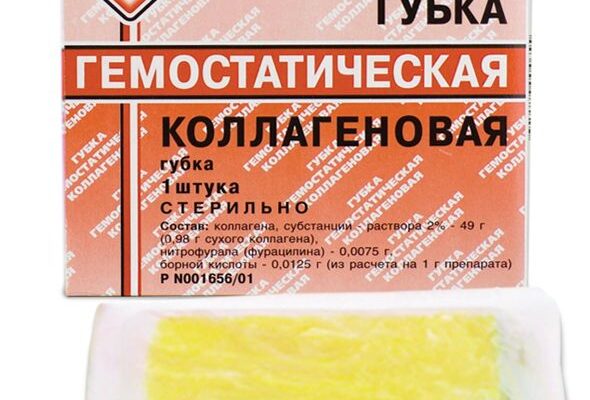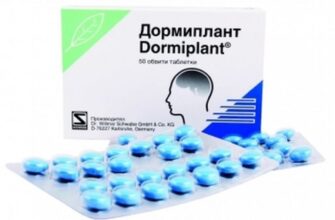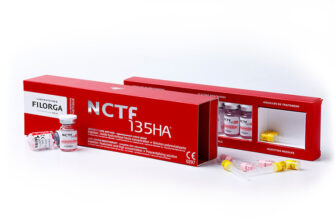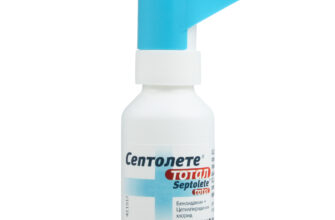Review of the best according to the editorial board. On the selection criteria. This material is subjective and does not constitute advertising and does not serve as a purchase guide. Before buying, you need to consult with a specialist.
If a surgeon was given an assignment to give a lecture on such a topic, he would be a little puzzled. What is the best wound healing remedy? Does this suggest that the wound is already practically at the last, third stage of its existence, and we are talking only about epithelialization? Or is it necessary to talk fully about how to care for the wound in order to avoid mistakes? After all, there is no simply abstract, separately taken wound. Wounds resulting from accidents can be burns and stabs, bitten and lacerations. In everyday life, there are wounds after cutting meat or fish, which are often just pricks with sharp bones. What about a wound in the most general sense of the word?
It turns out that in some cases, healing is very, very difficult. This may be due to lowered immunity, with unidentified bleeding continuing inside the wound. Wounds heal for a rather long time due to the addition of a secondary infection. Most often, enterobacteria and staphylococci multiply on the wound surface, in some cases, colonies of aerobic rods and diphtheroids are formed. If we are talking about injuries of the lower extremities, then E. coli and Proteus are often sown in patients. On burns, saprophytic staphylococcus most often appears, which usually lives on intact human skin.
Bite wounds are very dangerous. It is hardly necessary to repeat that a person should definitely go to an emergency room for the introduction of an anti-rabies vaccine, that is, 'get vaccinated' against rabies. But even if the animal turned out to be healthy, then the bitten and complicated wound contains peptostreptococci, pasteurella, corynebacteria, and various aerobic-anaerobic associations of harmful microbes.
In addition, wounds heal rather poorly in case of impaired blood circulation, due to arterial thrombosis, obliterating endarteritis, in the presence of diabetes mellitus and other diseases. But even the simplest wound must be properly treated. Currently, there are a lot of articles on the Internet in which the remedies are 'piled up in a heap', and it is not clear in what sequence and when to use them.
This material will talk about how to properly work with the wound, and all local medicinal products are presented for step-by-step use. This rating does not aim to find a 'better' or 'worse' remedy. It's just that each group includes the most popular and effective drugs. Also in this list is the range, or range of prices from the cheapest to the most expensive, which are found in pharmacies of all forms of ownership in the Russian Federation. The data is current for July 2019.
And, before proceeding to the list of medications, it is necessary to clearly understand the stages of wound treatment:
- the first and most necessary condition is to stop bleeding. The bleeding wound will never heal. It will get wet, excessive pressure will push the edges apart, and if large vessels are damaged, bleeding will lead to an immediate threat to life;
- in the presence of a chronic and poorly healing wound, there are necrotic areas in it, if it has not undergone primary surgical treatment, or excision within healthy limits. It contains tissue detritus and other organic substances that interfere with the appearance of fresh, granulation tissue and active wound healing. Therefore, the second stage will be cleaning the wound surface, removing necrotic masses, which will lead to stimulating its healing. This stage is especially important for the treatment of pressure ulcers, ulcers, which are long-term and chronic. Also, cleaning is crucial as is the removal of 'food' for germs;
- the third stage, which is sometimes carried out together with the second, will be prevention, or the fight against secondary infection that has joined. It is necessary to use drugs from this group for bitten, deep wounds that are contaminated with earth;
Finally, at the final stage of healing, repairs are needed, which improve the rate of formation of healthy tissue and help its epithelization. These are preparations from the group of reparants, and various dressings that establish the optimal microclimate inside the wound.
- Rating of the best wound healing remedies and their proper treatment
- Stopping bleeding
- Hemostatic sponge
- Advantages and disadvantages
- Hemosorb
- Advantages and disadvantages
- Silkoplast Comfort It-Hemo Hemostatic
- The best cleaners for necrosis
- Salicylic ointment
- Advantages and disadvantages
- Chimopsin (trypsin + chymotrypsin)
- Advantages and disadvantages
- Prontosan
- Advantages and disadvantages
- Sorbalgon
- Advantages and disadvantages
- The best remedies to fight infection
- Streptocide powder
- Advantages and disadvantages
- Supirocin (Mupirocin)
- Advantages and disadvantages
- Levomekol
- Advantages and disadvantages
- Sulfargin (silver sulfadiazine)
- Advantages and disadvantages
- The best reparants
- Panthenol (dexpanthenol)
- Advantages and disadvantages
- Voskopran with methyluracil
- Advantages and disadvantages
- HydroClean Plus / Hydroclin Plus
- Advantages and disadvantages
- Comfil plus
- Advantages and disadvantages
Rating of the best wound healing remedies and their proper treatment
| Nomination | a place | Name of product | price |
| Best Remedies to Stop Bleeding | 1 | Hemostatic sponge | 204 RUB |
| 2 | Hemosorb | RUB 30 | |
| 3 | Silkoplast Comfort It-Hemo Hemostatic | 248 r | |
| THE BEST MEANS FOR CLEANING FROM NECROSIS | 1 | Salicylic ointment | RUB 24 |
| 2 | Chimopsin (trypsin + chymotrypsin) | 1043 RUB | |
| 3 | Prontosan | 755 RUB | |
| 4 | Sorbalgon | 1900 RUB | |
| BEST Drugs to Fight Infection | 1 | Streptocide powder | RUB 7 |
| 2 | Supirocin (Mupirocin) | 715 RUB | |
| 3 | Levomekol | 127 RUB | |
| 4 | Sulfargin (silver sulfadiazine) | 410 RUB | |
| BEST Reparants | 1 | Panthenol (dexpanthenol) | RUB 90 |
| 2 | Voskopran with methyluracil | RUB 880 | |
| 3 | HydroClean Plus / Hydroclin Plus | RUB 315 | |
| 4 | Comfil plus | RUB 160 |
Stopping bleeding
Hemostasis, or stopping bleeding, must be quick and effective. If the main vessels are affected, then a tourniquet is indispensable. But after the tourniquet is applied, an active hemostatic drug must be placed in the wound. There are several groups of topical hemostatics, which are based on different principles. So, in the USA in 2002, the so-called QuikClot was adopted to supply the army. It is a clotting activator consisting of dried zeolite that completely removes water from the blood. She has no choice but to curl up and stop bleeding.
For greater effect, QuikClot is applied under the compression bandage. There are mucoadhesive hemostatics. They are able to stop capillary bleeding, but over a large area. This bleeding occurs under slight pressure. And if the drug adheres to the wound surface, then it seals this surface and accelerates the process of hemostasis. What kind of hemostatic agents can be purchased in modern pharmacies? Here they are.
Hemostatic sponge
Rating: 4.9
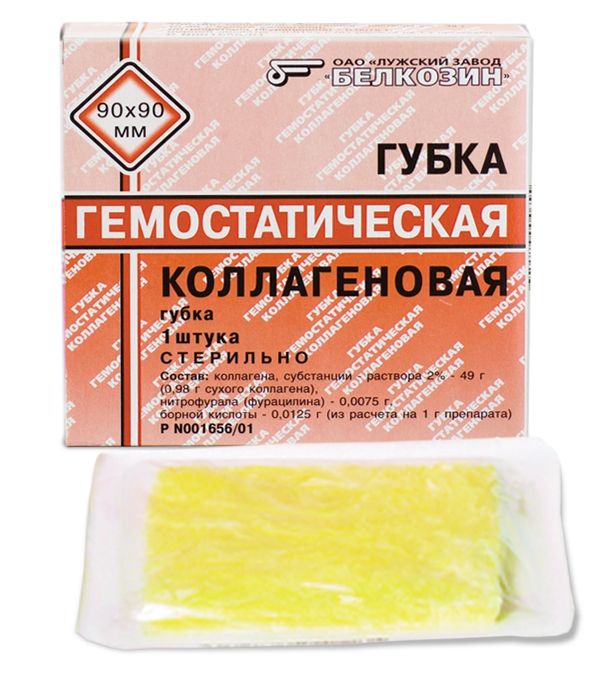
A hemostatic sponge is perhaps the easiest and most inexpensive way to stop minor bleeding. It is prepared from human donor blood, or dry plasma, and contains some calcium chloride, which improves blood clotting. The sponge is a yellowish porous mass, and since the sponge contains fibrin and thrombin, it activates clotting, and stops not only capillary bleeding, but also parenchymal bleeding, and therefore can be used intraoperatively for incisions of internal organs. This sponge is shown for use in various local wounds.
With the help of a sponge, bleeding from the gums, nosebleeds, and not only in healthy people, but also in patients with thrombocytopenia, hemorrhagic syndrome and cirrhosis of the liver, are successfully stopped, since the sponge itself contains the necessary elements of the blood coagulation system that are absent in these patients.
The hemostatic sponge should be used after draining the bleeding area by applying a sponge to it and pressing it to the wound for 3-5 minutes, preferably with a sterile napkin.
A collagen sponge is produced in different sizes: a square with a side of 5 cm, 9 cm and 10 cm. Such a square costs from 100 to 150 rubles, it is produced by the domestic company Belkozin. Naturally, such a square can be cut or torn into pieces of the required size.
Advantages and disadvantages
The advantage of a hemostatic sponge will be its low cost, the ability to successfully use it with a deficiency of coagulation factors and hemorrhagic syndrome in patients, the ability to divide the sponge into the necessary fragments. The disadvantage is the impossibility of stopping heavy arterial bleeding, but in the presence of a tourniquet, a hemostatic sponge may be needed.
Hemosorb
Rating: 4.8
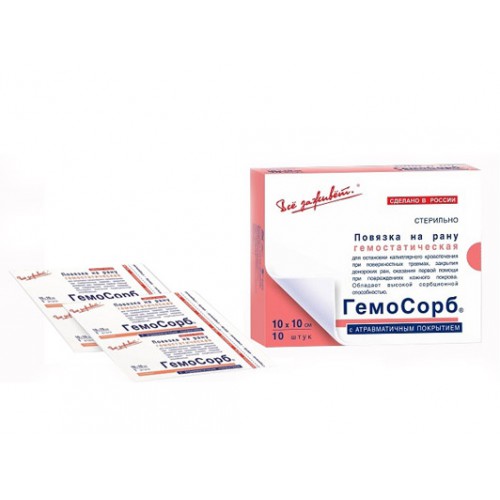
Hemosorb is a hemostatic dressing, which measures 10 by 10 centimeters in the shape of a square, and is produced by the domestic companies Biotekpharm. This dressing is highly absorbent and made of a special cloth with increased adsorption properties. On the outside and inside, the dressing is covered with a special micro-mesh, which is impregnated with calcium chloride. As you know, calcium salts are very good at stopping blood, since calcium is involved in the process of coagulation hemostasis. This dressing is indicated for superficial wounds and injuries in first aid. The dressing is sterile and hermetically sealed. For use, after opening or cutting the package, apply Hemosorb on the surface, and press firmly for 1 or 2 minutes. You can apply a pressure bandage, fix it with an elastic bandage or plaster. After the bleeding has stopped, the dressing is removed.
Advantages and disadvantages
The advantage of this dressing is its low cost, the need to press it for only one or two minutes, with capillary bleeding. The disadvantage is the fact that it is not cut into pieces and is sold only in the form of a single bandage, the impossibility of using it in case of severe, extensive bleeding, with secondary bleeding if there are purulent and necrotic areas on the surface.
Silkoplast Comfort It-Hemo Hemostatic
Rating: 4.7
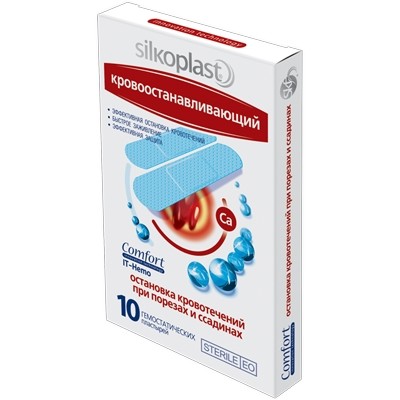
This special hemostatic plaster is used for small household wounds, cuts, abrasions. It is successfully used after taking blood from a vein to stop large bleeding. This patch is produced by the Formoplast company from Italy. The patch is available in the form of 10 plates, which have a small area and can close a small wound no more than 1-2 cm long.
The patch consists of an elastic, porous base that stretches easily and is able to cover any surface rather tightly. The patch does not come off when moved, as it is stretchable and resilient. The active ingredient that helps to intensively stop bleeding is calcium alginate, a special gel-like substance made from seaweed products enriched with calcium. Calcium facilitates clotting, and the protective gel penetrates deeply and works not in areas, but in volume, therefore, with small, but even heavily bleeding wounds, it is very effective. There is one package of Silkoplast, consisting of 10 small strips – from 185 to 350 rubles.
By the way, many sites have articles Voskopran with methyluracilomy, which were written by non-professionals. As a result, local hemostasis is proposed to be carried out by other means. By some miracle, Wessel Douai F gets into hemostatic agents to stop bleeding, and even Heparin, which thins the blood and, on the contrary, does not improve thrombus formation, but increases blood fluidity. In the case when it comes to wounds, and the count goes to minutes or hours, it makes no sense to use Dicinone, ethamsylate, aminocaproic acid, and so on. All these drugs are administered parenterally in the hospital, and serve for course treatment, for example, for preoperative preparation or emergency relief of DIC. As you can see, bleeding is handled differently.
The best cleaners for necrosis
After it has been possible to achieve stable hemostasis, it is necessary to eliminate all dead tissues, necrotic masses, tissue detritus. All this can serve as a food source for microorganisms and, in the end, lead to infection and suppuration. A wound cleaned in time can begin to granulate immediately and heal very well. There are many different chemical and enzyme preparations that can cleanse the wound. The most popular and effective medicines are listed in this rating.
Salicylic ointment
Rating: 4.9
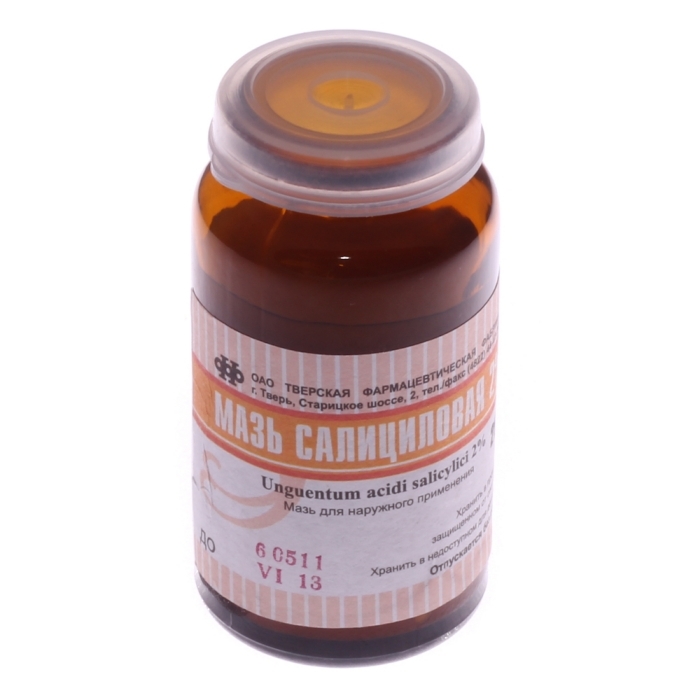
2% salicylic ointment is the cheapest drug that has an antiseptic effect, cleanses wounds, and reduces the effect of inflammation. Along the way, Salicylic ointment has an antimicrobial effect, although it is neither a pure antiseptic nor an antibiotic. The ointment is applied locally in a thin layer on the wound, under a sterile napkin, and the wound is closed. It is advisable to clean the wound from necrosis before applying the dressing, open the blisters, and rinse with an antiseptic, such as chlorhexidine, or Miramistin. After 2-3 days, you need to change the dressing, and completely re-treat the wound. The average duration of the course of treatment is from a week to 3 weeks. During this period, complete cleansing of pus and necrosis usually occurs. The cost of one jar of salicylic ointment weighing 25 grams is very low, and ranges from 19 to 25 rubles. Produces salicylic ointment Tula pharmaceutical factory.
Advantages and disadvantages
The advantage is a low price, widespread use, a wide range of actions. But salicylic ointment has rather weak pronounced properties, both cleansing and disinfecting and anti-microbial. It is quite possible to use it, but there is no need to expect a quick effect from it, and in some cases the treatment is delayed for a whole month. Nevertheless, it is and will be applied, including in budgetary healthcare institutions, where the price plays a decisive role in the amount of funding.
Chimopsin (trypsin + chymotrypsin)
Rating: 4.8
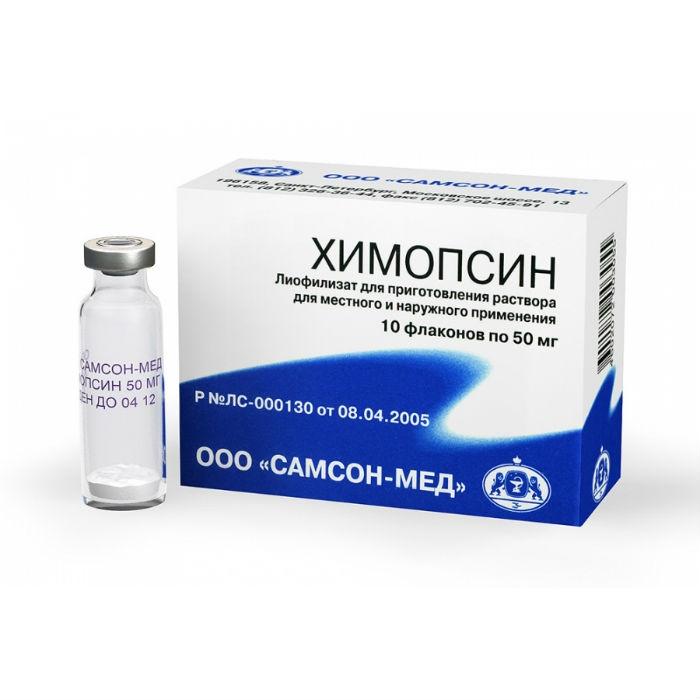
Chymopsin is already a more serious drug, it is a mixture of two enzymes, trypsin and chymotrypsin. They are obtained from the pancreas of farm animals, in the same way as enzyme preparations for the treatment of chronic pancreatitis. The same enzymes that digest proteins in humans in the intestines, digest both proteins and purulent-necrotic masses inside the wound. It is important that chymopsin does not affect healthy tissue, but only digests dead tissue, just like the larvae of a common fly are able to cleanse a wound from necrosis and not eat living tissue.
In addition, chymopsin liquefies viscous secretions, and after its treatment, the wound should be well rinsed with a disinfectant solution, or saline solution. Shown Himopsin, in addition to the treatment of purulent wounds, in ophthalmology, with herpetic keratitis, with purulent sinusitis and purulent otitis media, for thinning sputum, with bronchopulmonary purulent diseases.
It is applied at the rate of 1 gram per 100 square centimeters of the wound surface, and a bandage moistened with isotonic sodium chloride solution is applied on top. After a day, the dressing must be changed with wound treatment or and cleaning. A moisture-proof layer is applied on top to prevent the dressing from drying out. The domestic pharmaceutical company Samson-Med produces Himopsin, and a package of 5 vials of 5 ml each will cost from 480 to 530 rubles.
Advantages and disadvantages
The advantage of this remedy will be a fairly good cleaning of the wound, which protects it from the attachment of secondary microbial flora and facilitates healing, but still this remedy does not have antimicrobial activity, and therefore if pure Himopsin is applied, the wound will not be protected from microbes. This remedy also has contraindications: chronic heart failure, malignant neoplasms, liver cirrhosis, hemorrhagic diathesis. This drug should not be applied to decaying and malignant tumors and bleeding wounds. Of the side effects, usually only an allergic skin reaction can occur.
Prontosan
Rating: 4.7
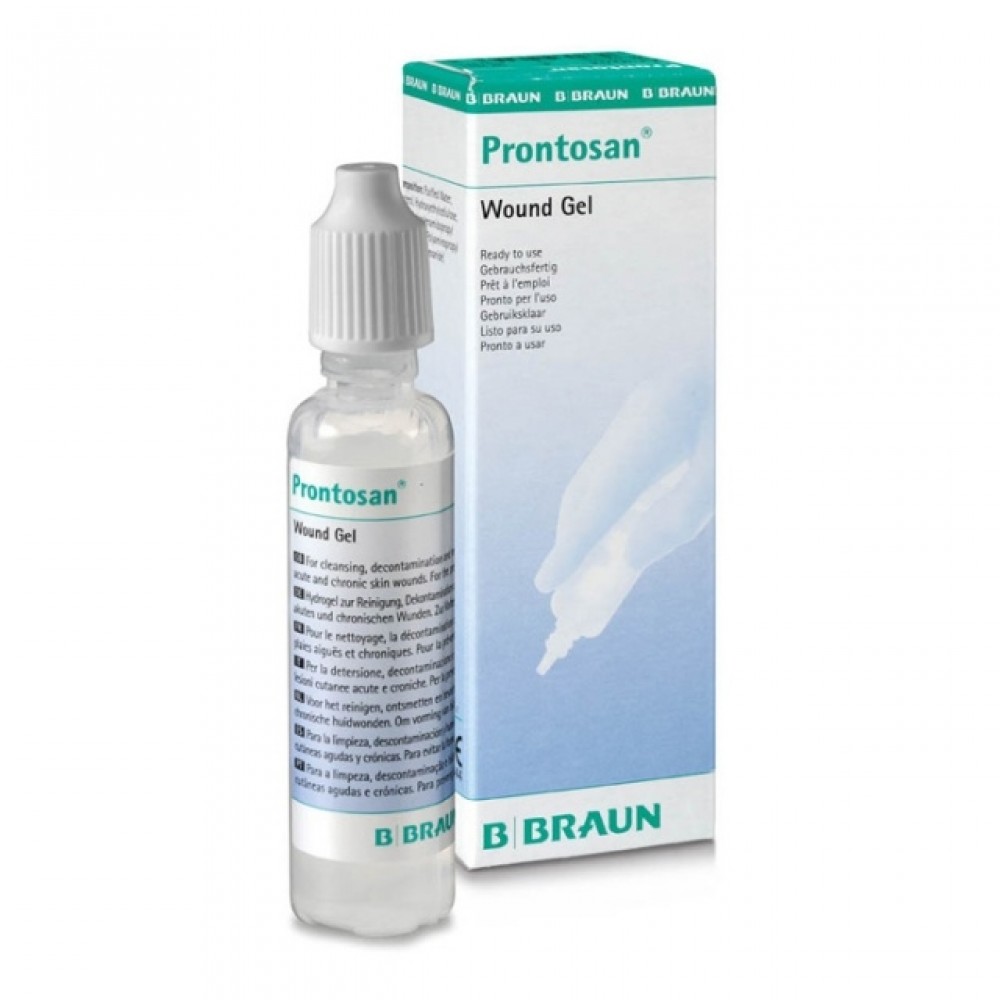
This is a modern sterile gel that cleanses, moisturizes, and disinfects a wide variety of wounds. In addition, it is able to absorb the unpleasant odor from the wound, and can be applied to the wound for up to several days. The drug has a wide range of antimicrobial action, including against Pseudomonas aeruginosa, streptococci, staphylococci, E. coli and fungi.
Prontosan is indicated for the treatment of especially long-term non-healing wounds and trophic ulcers, in the presence of aggravating pathology. These are vascular insufficiency, diabetes mellitus, oncology, various immunodeficiencies. Prontosan helps accelerate wound healing by absorbing exudate, various crusts and dead tissue, and cellular detritus. Such a thorough cleaning is accompanied by the suppression of microbial flora, and therefore this tool can immediately belong to two groups: antibacterial and wound cleansing, it is very convenient. In addition to the usual wounds, festering and necrotic, it can be used in the treatment of burns, and the treatment of holes near various catheters, probes and stomas.
The drug is quite simple to use. First, you need to rinse the wound with this agent, while capturing healthy skin, and then apply a gauze pad moistened with Prontosan on the surface of the wound. Wound dressings should be done daily. There is also a prontosan gel, which is best used if there is an abundant accumulation of fibrin, crusts, and, in general, denser tissues in the wound, since the water-holding capacity of the gel is much higher than that of the solution.
Prontosan is produced by the well-known company B Braun from Germany, and one bottle of this gel weighing 30 grams will cost from 600 to 800 rubles in Russia.
Advantages and disadvantages
Perhaps the main advantage is its combined action, as mentioned above. It also inhibits microbial growth, and allows you to cleanse the wound. But, besides this, it is very well tolerated, it is hypoallergenic and very effective in the case when the edges of the wound heal poorly, and the epithelium on them is poorly formed. It is compatible with many modern dressings and is colorless and odorless. If the bottle with Prontosan is opened, then it can be used for another 2 months. Contraindications include intolerance; contact with the eyes should be avoided.
Sorbalgon
Rating: 4.6

Finally, Sorbalgon should be mentioned in this section. This is a large dressing, which is a square with sides of 10 cm, consisting of alginate gel and calcium fibers. When these substances combine with sodium salts that are in the blood, a lush hydrophilic gel is formed, which fills the wound, but does not stick to its walls. This ability makes it possible with its help to care for especially deep wounds with uneven edges. It is used to treat pressure ulcers, boils and abscesses, diabetic ulcers, and even bleeding wounds, and in the decay of malignant tumors.
It is simple to use. Sorbalgon is simply matched to the size of the wound, tightly applied and fixed on it. Calcium alginate fibers completely turn into a gel, usually in a day or two, and this is how long the dressing can be on the wound. After this time, the gel is removed with tweezers, and what remains in the wound can be rinsed with normal saline from a syringe under pressure.
This bandage is produced by a well-known German company specializing in care products – Paul Hartmann, and one square will cost from 300 to 900 rubles.
Advantages and disadvantages
The obvious advantages of this care product is the ability to easily care for deep wounds of complex configuration, with tamponade of all kinds of cavities and pockets. This is also the effect of hemostasis, therefore Sorbalgon can be used in the case of wounds with insufficiently well-conducted stopping of bleeding, with a pronounced exudative component. Finally, the drug is easily removed from the wound. Perhaps the only drawback is the high cost, the absence of an antibacterial component.
The best remedies to fight infection
After the wound bleeding is stopped, the wound is cleaned – half the battle is done on the way to fight the infection. Moreover, a clean wound cannot be considered clean simply because it is not contaminated. It is necessary to use antibacterial agents in any case. Moreover, this should be done if inflammation appears around the edges of the wound, purulent masses are visible in the wound, an unpleasant odor or even air bubbles appear. The latter is generally an extremely alarming sign of incipient gas gangrene. In the depths of puncture wounds, tetanus sticks can be found, which do very well without oxygen. Therefore, if you do not have any means for treating wounds at hand, then at first, hydrogen peroxide is perfect, which can be directed from a bottle under pressure to the wound and rinsed thoroughly. Chlorhexidine, Furacilin or Miramistin are excellent for such a purpose. What preparations are produced specifically for application to wounds with an antibacterial purpose?
Streptocide powder
Rating: 4.9
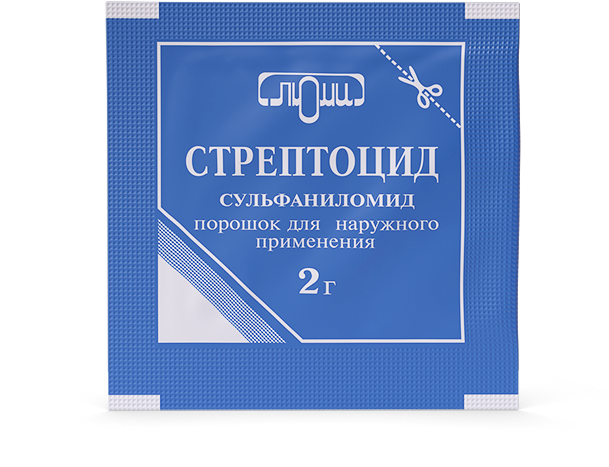
The first and most inexpensive, democratic and well-known drug is a simple streptocide, from the group of sulfonamides, packaged in sachets weighing 2 grams. Streptocid is an odorless, white crystalline powder and is a versatile antimicrobial agent. They need to be sprinkled on wounds that are suspicious of an infection, already infected and purulent wounds, burn wounds, it is used to treat erysipelas. It can also be used for prevention. With deep lesions, for example, with stab or bite wounds, it is injected into the wound cavity in large volumes – up to 15 grams. Streptocide is produced by a large number of various domestic pharmaceutical enterprises, for example, Lekar, Tula Factory, Aromasintez. The cost of one package weighing 2 grams does not exceed 35 rubles.
Advantages and disadvantages
The advantage of Streptocide is its cheapness, it can be bought at any pharmacy, the bag is not afraid of dampness and can be perfectly used in field conditions. However, Streptocide is one of the oldest antimicrobial drugs, and over the long decades of its use, most microorganisms already have strains resistant to this 'ancient' agent. In addition, with frequent use, this sulfonamide can cause headache, dizziness, and allergic reactions. Therefore, Streptocide can be considered the initial means of 'first aid', and not try to treat severe cases with it, such as long-term non-healing purulent wounds. Of course, it would certainly be effective in those years when microbes had not yet become familiar with antibiotics, like simple penicillin during the Second World War, but not in our time.
Supirocin (Mupirocin)
Rating: 4.8
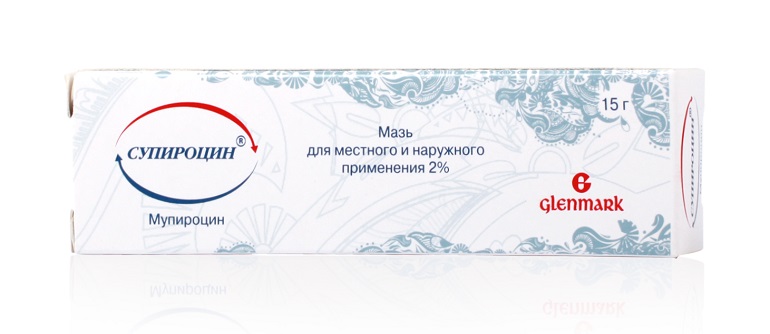
Supirocin is a modern ointment produced by the Indian company Glenmark Pharmaceuticals, and its cost is quite high: one tube of ointment weighing 15 grams can be purchased at a price of 520 to 800 rubles. The active substance will be mupirocin, which suppresses the development of pathogens of very many skin infections that are gram-positive. These are staphylococci, and their resistant strains, including methicillin, erythromycin and fusidic acid. These are streptococci, Escherichi, hemophilia, Klebsiella and other representatives of the aerobic and anaerobic flora. Supirocin is indicated for the primary prevention and treatment of wounds bitten by predators, in the presence of skin infections such as furunculosis and impetigo, for the treatment of minor burns and wounds. By the way, this ointment can be used intranasally for microbial damage to the nasal cavity. The ointment must be applied to the wound up to 3 times a day, but no longer than 10 days.
Advantages and disadvantages
The advantage of this drug is that it can be considered a highly effective reserve antibiotic, since it reacts even to resistant strains. But this advantage can also be considered a disadvantage, since in the case of an ordinary wound, using 'heavy artillery' at once is harmful in this case. This drug should be left to last, just in the event that there are wounds in patients with diabetes, obliterating endarteritis or immunodeficiency, which heal poorly. The usual banal suppuration can be cured by simpler means. It should also be remembered that this ointment should not be used during pregnancy and lactation, until the age of 12.
Levomekol
Rating: 4.7
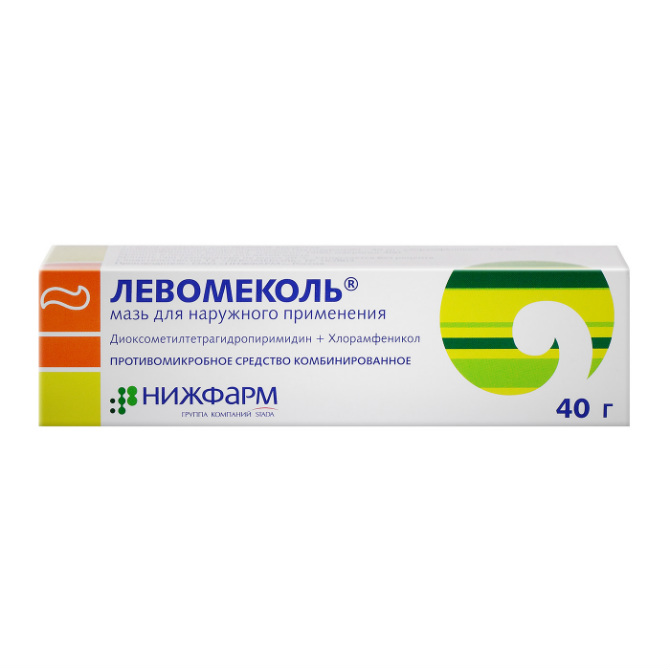
Levomekol is a popular ointment that combines an antibacterial effect due to the antibiotic chloramphenicol, and a dermatotropic, reparative, healing effect due to methyluracil. The medication is usually applied to a sterile gauze pad and the wound is filled with the tissue. For small wounds, the ointment can simply be applied to the surface. In the presence of purulent-necrotic masses, this drug promotes their rejection, especially if the ointment is heated to body temperature and becomes liquid. But such treatment of wounds is used in a hospital. It is advisable to apply Levomekol ointment to the wound under the bandage, since any ointment always stains clothes and is oily. Levomekol is produced by the domestic company Nizhpharm, one tube weighing 40 grams will cost from 100 to 120 rubles, which is quite inexpensive.
Advantages and disadvantages
The big plus of Levomekol is the combination of an antibacterial agent and a reparant, low price, availability, the ability to apply to almost any wounds, including deep, crushed, and bitten ones. However, the disadvantage is the fact that chloramphenicol is still not quite a modern drug, and resistance gradually develops to such an ointment, up to 40% of all cases. Therefore, in the event that no improvement is found 2-3 days after the application of Levomekol, this ointment should be changed to another local antibacterial drug.
Sulfargin (silver sulfadiazine)
Rating: 4.6
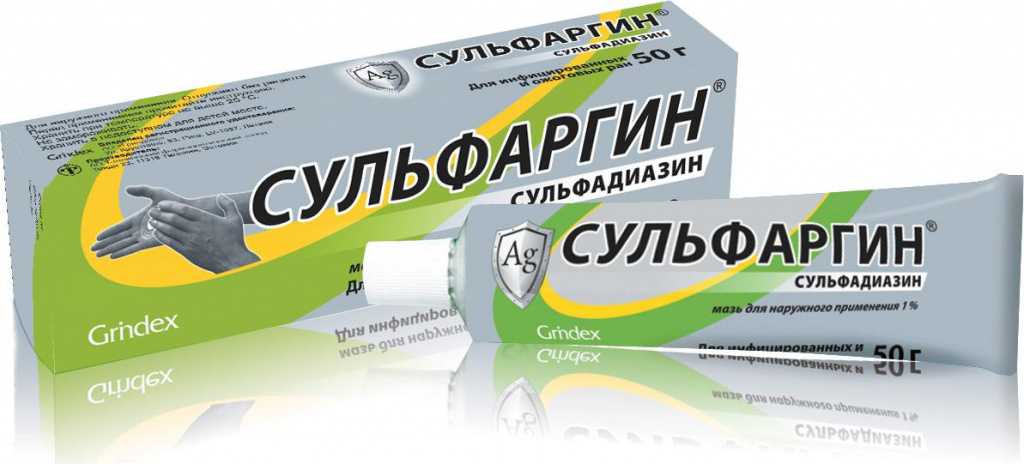
This unique drug is produced by an Italian company, and is an active compound from the group of sulfonamides – namely sulfadiazine in combination with silver. One gram of the ointment contains 10 milligrams of this active ingredient, and the rest are auxiliary substances. Sulfargin is prepared in petroleum jelly, and therefore it is advisable to apply it at night, under a bandage, since greasy marks stain clothes. In addition to bactericidal, silver has an antifungal effect, and the ointment is active against a variety of microorganisms, both gram-negative and gram-positive. Silver ions are constantly released inside the wound from the silver salt, and this leads to the fact that the effect of the ointment does not end, but lasts constantly. In addition, this remedy pulls everything out of the wound a little, that is, it has a moderate osmotic activity.
The drug is indicated for the treatment of infected wounds and burns, various abrasions, with complicated skin grafting, and for the treatment of clean wounds as a prevention of their infection. Sulfargin costs from 220 to 390 rubles for one small package of ointment weighing 15 grams.
Advantages and disadvantages
A big plus of Sulfargin is the osmotic effect and the constant preservation of the concentration of silver, the ability to use it for prophylaxis, effectiveness against rather complex wounds, trophic ulcers, pressure ulcers, including those that are not healing for a long time. However, it should be remembered that if the wound is extensive or very deep, then the drug is able to be absorbed into the bloodstream, and increase to a concentration of 10 or even 20 micrograms per liter. It can cause systemic effects, hematopoietic disorder, dyspepsia, and even hepatitis and toxic nephrosis. Therefore, sulfadiazine is desirable for localized wounds.
The best reparants
Finally, the last group of drugs, which is used at the final stage of wound treatment, when both microbial infection and cleaning are already behind, are various reparants. These include quite famous ones, such as Actovegin ointment and Solcoseryl, some modern drugs that are listed in this list.
Panthenol (dexpanthenol)
Rating: 4.9

Panthenol ointment has close relatives, for example, a spray can of Panthenol, or Bepanten ointment. In all cases, the main active ingredient is Dexpanthenol, which has a dermatoprotective effect. This substance stimulates skin regeneration, increases the strength of collagen fibers, and penetrates deep into all layers of the skin. Along the way, Dexpanthenol has a weak anti-inflammatory effect. It is indicated in the presence of wounds, at the stage of their healing, in the treatment of pressure ulcers, poorly healing skin grafts after transplantation, in the presence of various inflammatory skin processes. These are boils, dermatitis, the presence of the so-called varicose dermatitis. You can also use this ointment even due to the effect on the skin of dampness, cold and wind, with diaper rash in children, with cracks in the nipples when feeding babies, as a means to protect dry skin. Panthenol is produced by many different domestic companies. So, a tube of ointment weighing 25 grams, produced by Ozone LLC, will cost no more than 189 rubles.
Advantages and disadvantages
There are few contraindications to the use of the drug, only hypersensitivity. It can be used by pregnant and lactating mothers, and the side effect, which is expressed in allergic reactions, is extremely rare. The disadvantage is the need for frequent application, up to 4 times a day or even more often. If the wound has not yet been cleared of microorganisms, and is infected, then you must first apply an antiseptic, or agents from the infection control group. The duration of use is not limited, you can also apply Panthenol under a wet dressing.
Voskopran with methyluracil
Rating: 4.8
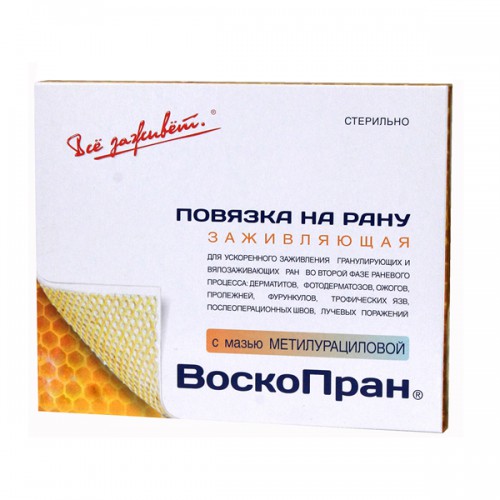
Voskopran with methyluracil is a modern dressing of the domestic company Biotekpharm, and one dressing measuring 10 by 25 cm costs an average of 160 rubles, and a pack of 10 is sold at prices ranging from 700 to 1000 rubles. This napkin is a polyamide fabric mesh on which methyluracil ointment is applied. The mesh nature of the material allows exudate to be removed, to give oxygen to the wound, and, thereby, further accelerate healing. The remedy is called Voskopran, because the additional coating contains natural beeswax, which has always been an active wound-healing component. Methyluracil ointment additionally enhances the work of wax, and Voskopran should be used already in the later stages, when it is already cleaned early, does not bleed for a long time, and there is no trace of microbial infection. Therefore, it is desirable to use waxed in the treatment of granulating wounds when they are sluggish, including diabetic wounds and burns. It is necessary to apply this bandage so that it completely overlaps the frame and protrudes slightly beyond its edges. After the bandage has been applied, the second protective layer is removed, and it remains on the wound for several days, and if there is no inflammation, then until complete healing.
Advantages and disadvantages
The advantages of this remedy are cost-effectiveness, and there is no need to frequently change the dressing. But this can only be if the wound meets the conditions and is in the third stage of healing. The disadvantage is the high cost of the drug.
HydroClean Plus / Hydroclin Plus
Rating: 4.7
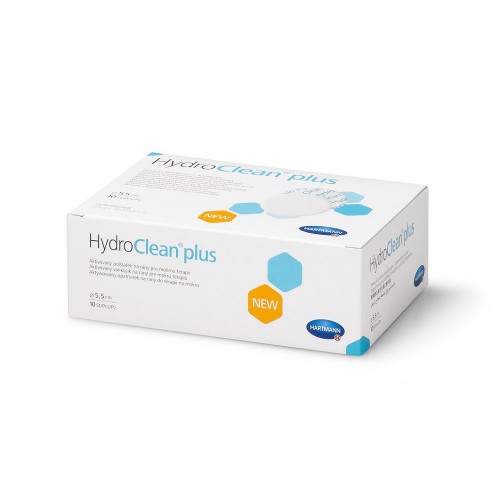
Hydroclin plus combines several wound healing mechanisms. These are high absorption, or absorption, antiseptic action, cleaning the wound surface from exudates and necrosis, and maintaining optimal conditions for epithelial growth. This dressing is used for long-lasting wounds that secrete exudate and are moist. Also, this napkin is successfully used to remove from the wound those enzymes that were applied to clean it, and now they, showing residual activity, began to interfere with healing. The dressing is 4 centimeters in size and round.
To apply a bandage, it must cover the edges of the wound and cover the healthy skin. The hydrocline is fixed with a bandage and is on the wound for no longer than 3 days. In order for the bandage to come off easily after 3 days, you need to moisten it with saline, after which it softens and is removed. The bandage is produced by Paul Hartmann, and a single small bandage costs 235 rubles.
Advantages and disadvantages
Like many modern means for dressing wounds, this dressing from a well-known company has a multi-component action, is a 'complex chemical engineering structure', and therefore it fully fulfills its cost. But this cost may not be affordable for the average Russian consumer. Pay an average of 235 rubles. for one bandage, which lasts a maximum of three days, and maybe even a day, is too expensive for many.
Comfil plus
Rating: 4.6

This is a Danish dressing from the Coloplast company. Comfil plus is, as in many cases, a sterile, single dressing measuring 10 by 10 centimeters. It is used in the final stages of the treatment of wounds, ulcers and pressure sores. Its task is to protect and strengthen the epithelium and prevent the possibility of secondary infection. Usually, two to five dressings are used for the course of treatment, while one dressing can stay on the surface of the wound for a long time – from 3 to 7 days. Perhaps this is one of the most 'long-lasting' dressings. It is very important that it can be used in the treatment of pressure sores and ulcers, but at the same time it is necessary that the wounds are absolutely clean, when there is no wound discharge, detritus, pus and necrotic tissue.
After applying Comfil, it well protects the wound from drying out, it does not crack, and such a rare change of dressing material has a very good effect on healing. In addition, the dressing is transparent, which allows you to observe healing without removing the dressing itself. There is a scale on the surface and it can help to check the size of the wound. Comfil plus acts mainly by physical factors, it provides an excellent balance between the state in the wound and evaporation, optimal for the growth of the epithelium.
Vachala, the wound is washed with an antiseptic, except for hydrogen peroxide and potassium permanganate. After drying the skin, Comfil plus is worn on the wound, the bandage should overlap the edges of the wound. The protective covering is removed, the bandage is applied and fixed. The cost of one such dressing, on average, is 275 rubles, and if a set of large dressings with a diameter of up to 15 centimeters is needed, then a pack of ten such dressings can cost 6000 rubles. and even more expensive.
Advantages and disadvantages
The advantages of this dressing are undeniable. Convenience, transparency, scale, creating a microclimate for a chronic wound or tongue are all extremely important, and, in the end, leads to their healing. The rare dressing change is especially valuable – up to 7 days, so the daily cost is only 40 rubles! The main condition is a clean wound. Torlko then this bandage will help the healing.
Attention! This rating is subjective and does not constitute an advertisement and does not serve as a purchase guide. Before buying, you need to consult with a specialist.

